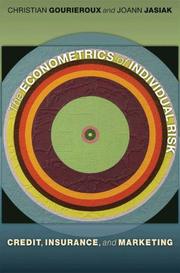| Listing 1 - 2 of 2 |
Sort by
|
Book
ISBN: 0081004788 1785480359 9780081004784 9781785480355 9781785480355 Year: 2015 Publisher: Oxford, UK : Elsevier Science,
Abstract | Keywords | Export | Availability | Bookmark
 Loading...
Loading...Choose an application
- Reference Manager
- EndNote
- RefWorks (Direct export to RefWorks)
Much research into financial contagion and systematic risks has been motivated by the finding that cross-market correlations (resp. coexceedances) between asset returns increase significantly during crisis periods. Is this increase due to an exogenous shock common to all markets (interdependence) or due to certain types of transmission of shocks between markets (contagion)? Darolles and Gourieroux explain that an attempt to convey contagion and causality in a static framework can be flawed due to identification problems; they provide a more precise definition of the notion of shock to strengthen the solution within a dynamic framework. This book covers the standard practice for defining shocks in SVAR models, impulse response functions, identitification issues, static and dynamic models, leading to the challenges of measurement of systematic risk and contagion, with interpretations of hedge fund survival and market liquidity risks Features the standard practice of defining shocks to models to help you to define impulse response and dynamic consequences Shows that identification of shocks can be solved in a dynamic framework, even within a linear perspective Helps you to apply the models to portfolio management, risk monitoring, and the analysis of financial stability.
Financial crises. --- International finance. --- Financial risk management. --- Risk management --- International monetary system --- International money --- Finance --- International economic relations --- Crashes, Financial --- Crises, Financial --- Financial crashes --- Financial panics --- Panics (Finance) --- Stock exchange crashes --- Stock market panics --- Crises

ISBN: 0691120668 0691168210 9786613339744 1283339749 1400829410 9780691120669 9781400829415 9781283339742 Year: 2007 Publisher: Princton, N.J. : Princeton University Press,
Abstract | Keywords | Export | Availability | Bookmark
 Loading...
Loading...Choose an application
- Reference Manager
- EndNote
- RefWorks (Direct export to RefWorks)
The individual risks faced by banks, insurers, and marketers are less well understood than aggregate risks such as market-price changes. But the risks incurred or carried by individual people, companies, insurance policies, or credit agreements can be just as devastating as macroevents such as share-price fluctuations. A comprehensive introduction, The Econometrics of Individual Risk is the first book to provide a complete econometric methodology for quantifying and managing this underappreciated but important variety of risk. The book presents a course in the econometric theory of individual risk illustrated by empirical examples. And, unlike other texts, it is focused entirely on solving the actual individual risk problems businesses confront today. Christian Gourieroux and Joann Jasiak emphasize the microeconometric aspect of risk analysis by extensively discussing practical problems such as retail credit scoring, credit card transaction dynamics, and profit maximization in promotional mailing. They address regulatory issues in sections on computing the minimum capital reserve for coverage of potential losses, and on the credit-risk measure CreditVar. The book will interest graduate students in economics, business, finance, and actuarial studies, as well as actuaries and financial analysts.
Econometrics --- Quantitative methods (economics) --- Risk (Insurance) --- Banks and banking --- Marketing --- Consumer goods --- Domestic marketing --- Retail marketing --- Retail trade --- Industrial management --- Aftermarkets --- Selling --- Agricultural banks --- Banking --- Banking industry --- Commercial banks --- Depository institutions --- Finance --- Financial institutions --- Money --- Insurance --- Risk management. --- Risk --- 305.6 --- AA / International- internationaal --- Risk management --- Risicotheorie, speltheorie. Risicokapitaal. Beslissingsmodellen --- E-books --- bankwezen --- econometrie --- marketing --- risk management --- verzekeringswezen --- 02.01.ZZD --- Verzekeringswezen ; Algemeen ; Meerdere landen
| Listing 1 - 2 of 2 |
Sort by
|

 Search
Search Feedback
Feedback About UniCat
About UniCat  Help
Help News
News